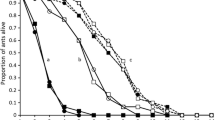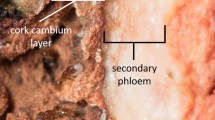Abstract
Social insects are at risk from a diverse range of parasites. The antibiotic-producing metapleural gland is an ancestral trait in ants which is thought to be one of their primary mechanisms of resistance. However, the metapleural gland has been lost secondarily in three ant genera, which include weaver ants that are characterised by the remarkable construction of their nests using larval silk. Silken nests may have allowed reduced investment in costly disease resistance mechanisms like the metapleural gland if the silk has antimicrobial properties, as in other insects, or is a hygienic substrate. Here we examine this hypothesis in the weaver ant Polyrhachis dives. We found no evidence of a beneficial effect of silk. The presence of silk did not improve the already high resistance of ants to the entomopathogenic fungus Metarhizium, the ants only rarely interacted with the silk regardless of whether they were exposed to Metarhizium or not, and silk also did not inhibit the in vitro germination or growth of Metarhizium. Furthermore, silk was found in vitro to be heavily contaminated with the facultative entomopathogenic fungus Aspergillus flavus, and many more ants sporulated with this fungus when kept with silk in vivo than when they were kept without silk. Further work is needed to examine the effects of silk on other parasites and of silk from other weaver ants. However, the results in combination suggest that silk in P. dives is unlikely to provide protection against parasites and that it is also not a hygienic substrate. Alternative explanations may therefore be needed for the loss of the metapleural gland in weaver ants.


Similar content being viewed by others
References
Beattie A.J., Turnbull C.L., Hough T. and Knox R.B. 1986. Antibiotic production - a possible function for the metapleural glands of ants (Hymenoptera, Formicidae). Ann. Entomol. Soc. Am. 79: 448-450
Boomsma J.J., Schmid-Hempel P. and Hughes W.O.H. 2005. Life histories and parasite pressure across the major groups of social insects. In: Insect Evolutionary Ecology (Fellowes M.D.E., Holloway G.J. and Rolff J., Eds). CABI publishing, Wallingford, UK, pp 139-175
Bot A.N.M., Ortius-Lechner D., Finster K., Maile R. and Boomsma J.J. 2002. Variable sensitivity of fungi and bacteria to compounds produced by the metapleural glands of leaf-cutting ants. Insect. Soc. 49: 363-370
Boucias D.G. and Pendland J.C. 1998. Principles of Insect Pathology. Kluwer, Norwell, MA
Brown W.L. 1968. An hypothesis concerning function of metapleural glands in ants. Am. Nat. 102: 188-191
Castella G., Chapuisat M. and Christe P. 2008. Prophylaxis with resin in wood ants. Anim. Behav. 75: 1591-1596
Chapuisat M., Oppliger A., Magliano P. and Christe P. 2007. Wood ants use resin to protect themselves against pathogens. Proc. R. Soc. Lond. B 274: 2013
Christe P., Oppliger A., Bancala F., Castella G. and Chapuisat M. 2003. Evidence for collective medication in ants. Ecol. Lett. 6: 19-22
Cremer S., Armitage S.A.O. and Schmid-Hempel P. 2007. Social immunity. Curr. Biol. 17: R693-R702
Dong C.J., Zhang J.M., Huang H., Chen W.G. and Hu Y.Y. 2009. Pathogenicity of a new China variety of Metarhizium anisopliae (M. anisopliae var. dcjhyium) to subterranean termite Odontotermes formosanus. Microbiol. Res. 164: 27-35
Freed S., Jin F.-L. and Ren S.-X. 2011. Determination of genetic variability among the isolates of Metarhizium anisopliae var. anisopliae from different geographical origins. World J. Microbiol. Biotechnol. 27: 359-370
Hölldobler B. and Engel-Siegel H. 1984. On the metapleural gland of ants. Psyche 91: 201-224
Hölldobler B. and Wilson E.O. 1990. The Ants. Belknap Press, Cambridge. 732 pp
Hughes W.O.H. and Boomsma J.J. 2004. Let your enemy do the work: within-host interactions between two fungal parasites of leaf-cutting ants. Proc. R. Soc. Lond. B 271: S104-S106
Hughes W.O.H., Eilenberg J. and Boomsma J.J. 2002. Trade-offs in group living: transmission and disease resistance in leaf-cutting ants. Proc. R. Soc. Lond. B 269: 1811-1819
Hughes W.O.H., Petersen K., Ugelvig L., Pedersen D., Thomsen L., Poulsen M. and Boomsma J.J. 2004a. Density-dependence and within-host competition in a semelparous parasite of leaf-cutting ants. BMC Evol. Biol. 4: 45
Hughes W.O.H., Thomsen L., Eilenberg J. and Boomsma J.J. 2004b. Diversity of entomopathogenic fungi near leaf-cutting ant nests in a Neotropical forest, with particular reference to Metarhizium anisopliae var. anisopliae. J. Invert. Pathol. 85: 46-53
Johnson R.N., Agapow P.M. and Crozier R.H. 2003. A tree island approach to inferring phylogeny in the ant subfamily Formicinae, with especial reference to the evolution of weaving. Mol. Phylogen. Evol. 29: 317-330
Keller S., Kessler P. and Schweizer C. 2003. Distribution of insect pathogenic soil fungi in Switzerland with special reference to Beauveria brongniartii and Metarhizium anisopliae. Biocontrol 48: 307-319
Korayem A.M., Hauling C., Lesch M., Fabbri M., Lindgren O., Loseva O., Schmidt M., Dushay S. and Theopold U. 2007. Evidence for an immune function of lepidopteran silk proteins. Biochem. Biophys. Res. Commun 352: 317-322
Lacey L.A. 1997. Manual of Techniques in Insect Pathology. Academic Press, London
Li B.C., Zhang S.Q., Dan W.B., Chen Y.Q. and Cao P. 2007. Expression in Escherichia coli and purification of bioactive antibacterial peptide ABP-CM4 from the Chinese silk worm, Bombyx mori. Biotechnol. Lett. 29: 1031-1036
Mackintosh J.A., Trimble J.E., Jones M.K., Karuso P.H., Beattie A.J. and Veal D.A. 1995. Antimicrobial mode of action of secretions from the metapleural gland of Myrmecia gulosa (Australian bull ants). Can. J. Microbiol. 41: 136-144
Meyling N.V. and Eilenberg J. 2006. Isolation and characterisation of Beauveria bassiana isolates from phylloplanes of hedgerow vegetation. Mycol. Res. 110: 188-195
Morelos-Juárez C., Walker T.N., Lopes J.F.S. and Hughes W.O.H. 2010. Ant farmers practice proactive personal hygiene to protect their fungus crop. Curr. Biol. 20: 553-554
Poulsen M., Bot A.N.M., Nielsen M.G. and Boomsma J.J. 2002. Experimental evidence for the costs and hygienic significance of the antibiotic metapleural gland secretion in leaf-cutting ants. Behav. Ecol. Sociobiol. 52: 151-157
Poulsen M., Hughes W.O.H. and Boomsma J.J. 2006. Differential resistance and the importance of antibiotic production in Acromyrmex echinatior leaf-cutting ant castes towards the entomopathogenic fungus Aspergillus nomius. Insect. Soc. 53: 349-355
Robson S.K.A. and Kohout R.J. 2005. Evolution of nest-weaving behaviour in arboreal nesting ants of the genus Polyrhachis Fr. Smith (Hymenoptera: Formicidae). Austral. J. Entomol. 44: 164-169
Rosengaus R.B., Maxmen A.B., Coates L.E. and Traniello J.F.A. 1998. Disease resistance: a benefit of sociality in the dampwood termite Zootermopsis angusticollis (Isoptera: Termopsidae). Behav. Ecol. Sociobiol. 44: 125-134
Schlüns H. and Crozier R.H. 2009. Molecular and chemical immune defenses in ants (Hymenoptera: Formicidae). Myrmecol. News 12: 237-249
Schmid-Hempel P. 1998. Parasites in Social Insects. Princeton Univ. Press, Princeton
St Leger R.J., Screen S.E. and Shams-Pirzadeh B. 2000. Lack of host specialization in Aspergillus flavus. Appl. Environ. Microbiol. 66: 320-324 doi:10.1128/aem.66.1.320-324.2000
St Leger R.J., Staples R.C. and Roberts D.W. 1993. Entomopathogenic isolates of Metarhizium anisopliae, Beauveria bassiana, and Aspergillus flavus produce multiple extracellular chitinase isozymes. J. Invertebr. Pathol. 61: 81-84
Sumner S., Hughes W.O.H. and Boomsma J.J. 2003. Evidence for differential selection and potential adaptive evolution in the worker caste of an inquiline social parasite. Behav. Ecol. Sociobiol. 54: 256-263
Sun B.D. and Liu X.Z. 2008. Occurrence and diversity of insect-associated fungi in natural soils in China. Appl. Soil Ecol. 39: 100-108
Ugelvig L.V. and Cremer S. 2007. Social prophylaxis: group interaction promotes collective immunity in ant colonies. Curr. Biol. 17: 1967-1971
Veal D.A., Trimble J.E. and Beattie A.J. 1992. Antimicrobial properties of secretions from the metapleural glands of Myrmecia gulosa (the Australian bull ant). J. Appl. Bacteriol. 72: 188-194
Walker T.N. and Hughes W.O.H. 2009. Adaptive social immunity in leaf-cutting ants. Biol. Lett. 5: 446-448
Wilson-Rich N., Spivak M., Fefferman N.H. and Starks P.T. 2009. Genetic, individual, and group facilitation of disease resistance in insect societies. Annu. Rev. Entomol. 54: 405-423. doi:10.1146/annurev.ento.53.103106.093301
Wilson K., Knell R., Boots M. and Koch-Osborne J. 2003. Group living and investment in immune defence: an interspecific analysis. J. Anim. Ecol. 72: 133-143
Acknowledgments
We are grateful to Pete Graystock for assistance with caring for the colonies, Martin Sebesta for supplying the ant colonies, Crystal Frost, Pete Graystock, Oliver Otti and two anonymous reviewers for comments on the manuscript, and the Leverhulme Foundation for funding.
Author information
Authors and Affiliations
Corresponding author
Rights and permissions
About this article
Cite this article
Fountain, T., Hughes, W.O.H. Weaving resistance: silk and disease resistance in the weaver ant Polyrhachis dives . Insect. Soc. 58, 453–458 (2011). https://doi.org/10.1007/s00040-011-0162-1
Received:
Revised:
Accepted:
Published:
Issue Date:
DOI: https://doi.org/10.1007/s00040-011-0162-1




